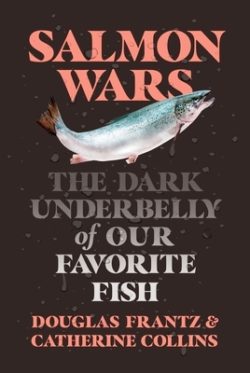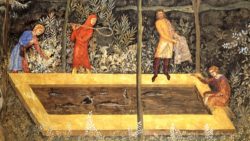Read Time: 5 Minutes Subscribe & Share
Salmon And Special Occasions
 One of my favorite birthday celebration dinners was my mother’s baked salmon with her “sauce verte” which she perfected (and I have not) from her usual source of recipes – The Joy Of Cooking – hers was the 1953 edition. She could go to the A&P grocery store (a once very powerful chain in the US) and order ahead a whole salmon from their fish counter. She then seasoned and baked it in aluminum foil in a slow oven. She made space in her refrigerator and allowed it to cool and then served it on a platter with a creamy but herby sauce. It was absolutely delicious and made a spectacular entrance to my family birthday party. As a side note, for dessert she regularly ordered a scrumptious mocha cake with toasted almonds from a Swiss bakery in Northwest DC. Both are lovely memories for me.
One of my favorite birthday celebration dinners was my mother’s baked salmon with her “sauce verte” which she perfected (and I have not) from her usual source of recipes – The Joy Of Cooking – hers was the 1953 edition. She could go to the A&P grocery store (a once very powerful chain in the US) and order ahead a whole salmon from their fish counter. She then seasoned and baked it in aluminum foil in a slow oven. She made space in her refrigerator and allowed it to cool and then served it on a platter with a creamy but herby sauce. It was absolutely delicious and made a spectacular entrance to my family birthday party. As a side note, for dessert she regularly ordered a scrumptious mocha cake with toasted almonds from a Swiss bakery in Northwest DC. Both are lovely memories for me.
The large salmon she purchased on special order was wild, not frozen or farmed, as this form of food production was just a small part of the salmon industry in those days. The price made salmon a moderately expensive treat. The increased availability of farmed fish globally, and particularly salmon, long remained kind of a hazy thought for me while standing in front of a seafood counter, looking at the prices between farmed and wild fish. I didn’t have well formed ideas of their relative merits, other than a vague sense that wild was better. So I would usually pick wild, but sometimes the price difference seemed too steep, or in some cases, only farmed was available. 
Reading Is Believing
I have been reading about the explosive growth of salmon farming in a book written by Catherine Colllins and Douglas Frantz, both having earned their chops in investigative journalism from The New York Times, The Chicago Tribune and The Los Angeles Times. This book, Salmon Wars, which is over 300 pages long, comes packed with details about the regulated (in name only ) salmon farming industry and its unsustainable trajectory. It offers up a pack of global villains, along with some valiant and tenacious heroes. The two authors also give us a robust rundown on the research for solutions to a form of aquatic farming that should be a part of our planet’s future.
How It Started
The ideas surrounding farming seafood are hardly new. A Swiss museum dedicated to many aspects of what we eat, Alimentarium, published a concise history of fish farming. Various dynasties in China left documentation of aquaculture as early as 1000 BCE. Romans bred oysters and maintained live seafood in pools (vivaria – something they picked up from the Assyrians). Growing fish for food in pools continued through the middle ages both by the feudal aristocracy and by monastic orders. This can be no surprise, as both controlled land and waterways through conquest, marriage, inheritance, and the power of the Catholic Church. Even today’s mussel farming has its roots in a 13th century invention. But both fresh crustaceans and fish remained food for the privileged for many centuries.
dynasties in China left documentation of aquaculture as early as 1000 BCE. Romans bred oysters and maintained live seafood in pools (vivaria – something they picked up from the Assyrians). Growing fish for food in pools continued through the middle ages both by the feudal aristocracy and by monastic orders. This can be no surprise, as both controlled land and waterways through conquest, marriage, inheritance, and the power of the Catholic Church. Even today’s mussel farming has its roots in a 13th century invention. But both fresh crustaceans and fish remained food for the privileged for many centuries.
Fresh water fish farming in artificial ponds became modernized during the Renaissance, with documents written about pond construction and fish farm management. But it was not until the Enlightenment that artificial breeding for fish was discovered in Germany. Still, it took the Industrial Revolution in the 19th century to bring fish farming into wide use in Europe. Even then, pollution and obstruction by dams and irrigation canals created dangerously low levels of wild fish populations. By the mid-19th century, artificial breeding and fish farming became common globally. Fish farming in some areas in Africa was also introduced as a way to lessen the ravages of malaria, as insect-eating fish promised both food and protection.
CAFOs In the Sea
What revolutionized aquaculture, though, was the implementation of ‘artificial granulated food’ in the 1950s. Salmon and similar fish are actually carnivores, and traditionally the farmed creatures dined on livestock mixed with grain products. The new pellets made feeding cheaper and used less small fry fish, which suffered stock depletion. Additionally, new materials and engineering introduced a cheaper means (if state permission were granted) to use in coves along the open sea rather than glass and steel tanks or even synthetic ponds on land. The first open cages for raising a particular fish proliferated in the Mediterranean Sea during the 1980s.
Salmon is by no means the only farmed fish. Tuna, tilapia, trout, sea bass, and branzino, for example, are all farmed, but salmon does represent the most visible example of how a once-seasonal fish became hamburger o’ the sea. There exist principled practitioners of salmon farming, but they are far outnumbered by a few global giants, who have billions of dollars behind them and subservient state governments. One of the hooks for these mega farms is that with tax forgiveness and subsidies offered to these corporations, regions with severe unemployment problems will overflow with new job opportunities. But as with the unsustainable future in Concentrated Animal Feeding Operations in several countries besides the US, these ocean farms are deeply polluting the sea floor beneath their moorings, spreading diseased fish into wild populations, meaning we are once again purchasing a food that has to be fortified with antibiotics. How do we get from this example in Scotland –
to this one in Spain?
As individual consumers, we have only some power in numbers. A helpful long-term bet to halting these polluting, damaging practices is to make informed purchases. We should know who the big players are in unsustainable aquaculture. We should know who the players are in a more sustainable aquaculture future and support them. We should let the stores know what we want, and hold out for it. Where aquaculture policy propositions are promoted, we should know what is involved. This article in Food Tank gives us a list of some of the current sustainable aquaculture companies. KD will have two posts in this series, inspired by the book Salmon Wars, where we will discuss both sets of players. Knowledge is indeed power.

Kitchen Detail shares under the radar recipes, explores the art of cooking, the stories behind food, and the tools that bring it all together, while uncovering the social, political, and environmental truths that shape our culinary world.




I thought your followers here in the Chesapeake Bay region would be interested in AquaCon’s proposed 25-acre indoor salmon farm on the Eastern Shore. A short but powerful opinion by key environmental and fisheries experts opposing AquaCon’s project: https://www.marylandmatters.org/2022/08/08/opinion-aquacons-proposed-industrial-salmon-farm-represents-a-major-environmental-risk-for-maryland/
Hello Lannie,
Thank you for sending me the link. I read every word. And I had no idea that this was being proposed for that area of the Chesapeake Bay.
Nancy